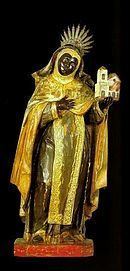 | ||
Venerated in Roman Catholic ChurchEastern Orthodox Church Feast September 21 (Roman Catholic Church)November 16 (Eastern Orthodox Church) | ||
Saint Ephigenia of Ethiopia or Iphigenia of Ethiopia (Spanish: Efigênia; Portuguese: Ifigênia; French: Iphigénie; Greek: Ἰφιγένεια), also called Iphigenia of Abyssinia (1st century), is a folk saint whose life is told in the Golden Legend as a virgin converted to Christianity and then consecrated to God by St. Matthew the Apostle, who was spreading the Gospel to the region of "Ethiopia".
Contents
Hagiographic life
According to the legend, Ephigenia was the daughter of Ethiopian King Egippus. She was dedicated to God by Saint Matthew the Apostle, who veiled her.
When Hirtacus succeeded the King, he promised the apostle half of his kingdom if he could persuade Ephigenia to marry him. Matthew thus invited the king to Mass the following Sunday where he explained that she was already espoused to the eternal King and thus could not be purloined by Hirtacus. The king thus sent a swordsman to kill Matthew who stood at the altar, making him a martyr.
Not having managed to bend Ephigenia to his will, Hirtacus tried to destroy her home with fire. However, the apostle appeared and warded the flames from the house, turning them upon the royal palace. The king's son was seized by the devil and the king himself contracted leprosy, eventually killing himself.
The people thus chose Ephigenia's brother as their king, who reigned for seventy years, leaving his kingdom to his son who filled Egypt with Christian churches.
Spain
The Carmelites of Cádiz, Andalusia, had a devotion to Santa Ifigênia. In Cádiz, African blacks organized their own religious association, the "Confradia de Nuestra Senora de le Salud, San Bello y Santa Ifigênia", formed in El Puerto de Santa María in 1575. From Cádiz, her devotion spread to Portugal and from there to Brazil.
Brazil
The Brazilian-born priest José Pereira de Santana devoted a definitive, two-volume work to Elesbaan and Ephigenia, published respectively in 1735 and 1738 at Lisbon. He considered them the two pillars of African sanctity and refashioned them as saints of his own Carmelite order. Elesbaan represented the triumph of Christianity over Judaism in the person of Dunaan, while Ephigenia stood for the early, voluntary acceptance of the Gospel in Africa.
A "Venerable Brotherhood of Saint Elesbão and Saint Efigênia" was founded in Rio de Janeiro on May 7, 1740, by free black slaves from Cape Verde, Coast of the Mine, São Tomé Island, and Mozambique. The cult of those two Saints is believed to have been brought by the slaves themselves. Black brotherhoods in Roman Catholic societies in the New World relied upon a few black patron saints, including Santa Efigenia, Santo Antonio de Catagerona (d. 1549), and Sao Benedito (d. 1589).
Saint Iphigenia was also honored in joyous religious festivals and processions. According to Brazilian sociologist and anthropologist Gilberto Freyre, writing in 1922, "the festival of Saint Ephigenia, a sort of black Madonna, was enjoyed to the utmost by the colored folks, whose "consciousness of kind" was ably aroused by the priests."
On November 20, 1995 Brazilians observed the 300th anniversary of the death of Zumbi of Palmers, the last ruler of Palmares, regarded as one of the first freedom fighters of the Americas. In Belo Horizonte a procession of congados (pt) took place on the evening of November 23, 1996, honoring Nossa Senhora do Rosario, Saint Benedict the Moor, and Saint Iphigenia with processions of precision marching, singing, dancing and the use of percussion instruments. The combined reverence for the Catholic saints and the performance of African ritual elements are evidence of the co-existence of Catholic religious traditions and the preservation of an African cultural memory in Minas Gerais.
Peru
The diaspora of Santa Efígenia from Ethiopia to the Americas was part of the dispersal of African popular religious expressions that connected Africa, Europe, and the Americas.
A late twentieth century movement to gain national recognition of Afro-Peruvian cultural contributions in Cañete Province focused on Santa Efigenia, which included a statue and an eighteenth century wall-sized baroque painting of her by Peruvian artist Cristóbal Lozano. These artistic representations located in a private chapel on the hacienda La Quebrada in San Luis de Cañete were presented as legitimate artifacts of Santa Efigenia’s status as a folk or popular saint central to their construction of an Afro-Peruvian black identity and culture of devotion.
On August 20, 1994 Sabino Cañas, an Afro-Peruvian community leader, organized a small group of followers from the surrounding villages of Cañete and Chincha to establish the Santa Efigenia Association, and named her as Patroness of National Black Art, even as they struggled to craft a coherent historical narrative of Santa Efigenia’s origins. According to the Association’s popular history, Santa Efígenia has been at the hacienda of La Quebrada since approximately 1741.
An annual celebration of Santa Efígenia is held on September 21 each year, with processions made in homage to Santa Ifigenia in the district of San Luis de Canete. The Association produces a program flyer that introduces a brief history of the patron saint and focuses on her diffusion and popularity in Brazil, Cuba, and Peru. The festival has grown in popularity as the Afro-Peruvian community of artists, musicians, writers, sports figures, and admirers have converged on Cañete each September in growing numbers.
France
In honor of Saint Ephigenia, a virgin-martyr of 1794 had taken her name. A professed religious of the Order of St. Benedict that was martyred during the French Revolution in 1794 was known as "Sister Iphigénie of Saint Matthew". Her name was Blessed Marie-Gabrielle-Françoise-Suzanne de Gaillard de Lavaldène (1761–1794), also known as "Francesca Maria Susanna", "Sister Iphigénie of Saint Matthew" or "Ifigenia di San Matteo de Gaillard de la Valdène", and she was one of the Martyrs of Orange who was guillotined on 7 July 1794 in Orange, Vaucluse, France. She was beatified 10 May 1925 by Pope Pius XI and she is commemorated on July 7.
